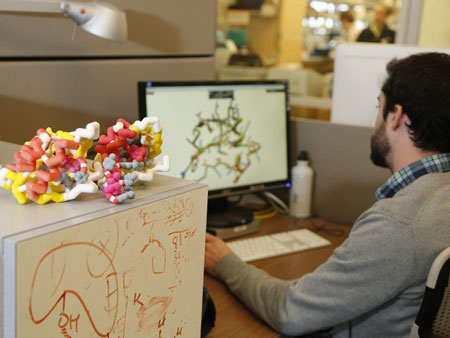| Posted: Dec 16, 2015 |
Big moves in protein structure prediction and design
(Nanowerk News) The potential of modular design for brand new proteins that do not exist in the natural world is explored Dec. 16 in the journal Nature. The reports are the latest in a recent series of developments toward custom-designing proteins.
|
|
Naturally occurring proteins are the nanoscale machines that carry out nearly all the essential functions in living things.
|
|
While it has been known for more than 40 years that a protein's sequence of amino acids determines its shape, it has been challenging for scientists to predict a protein's three-dimensional structure from its amino acid sequence.
|
|
Conversely, it has been difficult for scientists to devise brand new amino acid sequences that fold up into hitherto unseen structures. A protein's structure dictates the types of biochemical and biological tasks it can perform.
|
|
The Nature papers look at one type of natural construction: proteins formed of repeat copies of a structural component. The researchers examined the potential for creating new types of these proteins. Just as the manufacturing industry was revolutionized by interchangeable parts, originating protein molecules with the right twists, turns and connections for their modular assembly would be a bold direction for biotechnology.
|
 |
| Modeling protein molecule structures at the University of Washington Institute for Protein Design, where computer algorithms, such as Rosetta, and the computer game Foldit, were programmed to assist in creating new proteins from scratch.
|
|
The papers are "Exploring the repeat protein universe through computational protein design" and "Rational design of alpha-helical tandem repeat proteins with closed architecture". The findings suggest the possibilities for producing useful protein geometries that exceed what nature has achieved.
|
|
The work was led by postdoctoral fellows TJ Brunette and Fabio Parmeggiani in the lab of David Baker at the University of Washington Institute for Protein Design and Lindsey Doyle in the lab of Phil Bradley at the Fred Hutchinson Cancer Research Institute in Seattle.
|
|
In addition, over the past several months, researchers at the Institute for Protein Design at the University of Washington, the Fred Hutch, and their colleagues at other institutions have described several other advances in two long-standing problem areas in building new proteins from scratch.
|
|
"It has been a watershed year for protein structure predictions and design," said UW Medicine researcher David A. Baker, UW professor of biochemistry, Howard Hughes Medical Institute investigator, and head of the UW Institute for protein design.
|
|
The protein structure problem is figuring out how a protein's chemical makeup predetermines its molecular structure, and in turn, its biological role. UW researchers have developed powerful algorithms to make unprecedented, accurate, blind predictions about the structure of large proteins of more than 200 amino acids in length. This has opened the door to predicting the structures for hundreds of thousands of recently discovered proteins in the ocean, soil, and gut microbiome.
|
|
Equally difficult is designing amino acid sequences that will fold into brand new protein structures. Researchers have now shown the possibility of doing this with precision for protein folds inspired by naturally occurring proteins.
|
|
More importantly, researchers can now devise amino acid sequences to fashion novel, previously unknown folds, far surpassing what is predicted to occur in the natural world.
|
|
The new proteins are designed with help from volunteers around the globe participating in the Rosetta@home distributed computing project. The custom-designed amino acid sequences are encoded in synthetic genes, the proteins are produced in the laboratory, and their structures are revealed through X-ray crystallography. The computer models in almost all cases match the experimentally determined crystal structures with near atomic level accuracy.
|
|
Researches have also reported new protein designs, all with near atomic level accuracy, for such shapes as barrels, sheets, rings and screws. This adds to previous achievements in designing protein cubes and spheres, and suggests the possibility of making a totally new class of protein materials.
|
|
By furthering advances such as these, researchers hope to build proteins for critical tasks in medical, environmental and industrial arenas. Examples of their goals are nanoscale tools that: boost the immune response against HIV and other recalcitrant viruses, block the flu virus so that it cannot infect cells, target drugs to cancer cells while reducing side effects, stop allergens from causing symptoms, neutralize deposits, called amyloids, thought to damage vital tissues in Alzheimer's disease, mop up medications in the body as an antidote, and fulfill other diagnostic and therapeutic needs. Scientists are also interested in new proteins for biofuels and clean energy.
|

